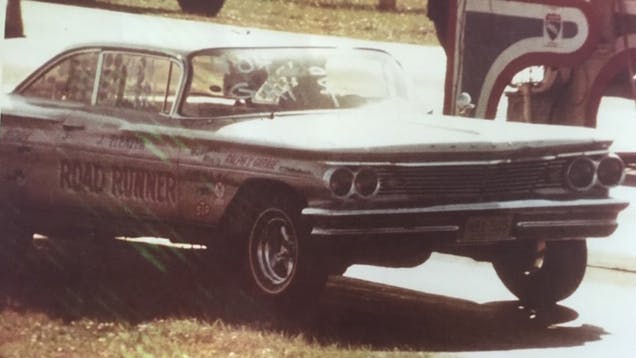Before the Road Runner was a Plymouth, it was a Pontiac

When John Eleazer bought his 1960 Pontiac Catalina, he didn’t have any plans to transform it into a drag-strip scorcher. He drove it back from the dealership into his driveway, not to a race shop, and the Catalina served its daily driver duties faithfully for five years.
Then Eleazer caught the drag-racing fever. He started tinkering with the Catalina’s 389-cubic-inch V-8. Out went the factory two-barrel carb and intake, and in went a four-barrel—and, eventually, a 3×2 setup. With more room to breathe on the intake side, he settled on long-tube headers to help the engine exhale. A drag racer was born.
If you frequented drag strips in the Northeast in the late 1960s, Eleazer and his four-speed Catalina were likely a familiar sight. The pair would race at New York National Speedway in Long Island on Friday, make quick, in-state stops at Westhampton and Albany, and be off to race at Dover Drag Strip in Wingdale, New York, all on the same weekend. Eleazer didn’t drive the race car from track to track, though; he towed it with a stock 1960 Catalina. It was a practical way of carrying spare parts, he explains: “If I broke something racing I’d take it off the car. If I didn’t break it again racing, I’d put it back on the tow car.”

Zipping from track to track on the weekends earned the Catalina an appropriate nickname: “Road Runner.” Eleazer embraced the moniker and lettered the car with the name.
Besides the quarter-mile, Eleazer and the Road Runner Catalina would race anywhere they could. Before Englishtown, New Jersey, had a proper dragstrip, Old Bridge Township had a track with a 1/16th-mile straightaway. That was enough track for Eleazer. (Drag races are won or lost at the tree, anyway.) He took any opportunity he could to line up against an opponent and launch the Road Runner down the track.

Inspired by the success of the factory lightweight Super Duty Catalinas and the Tin Indian Pontiacs raced at the time, Eleazer hoped to install a 421 in his Catalina. However, he couldn’t justify the expense of an all-new engine. So he rebuilt the 389, boring it .030-over in the process, and topped the freshened 395-cu-in short-block with the heads and dual four-barrel intake from a 421.
Mopar would later offer its own Road Runner muscle car, based on its mid-size, B-body architecture, but Eleazer still prefers his version. Despite the Mopar’s cool horn and great graphics, the Pontiac Road Runner has its own grassroots appeal. Did Eleazer’s Pontiac inspire the Plymouth of the same name? It’s hard to say, but the Pontiac was first, and it was making a worthy name for itself in the drag-racing scene.
That 421 top-end combo propelled Eleazer and the Road Runner to a United Hot Rod Association (UHRA) class record of 13.40 in 1972. Soon after, Eleazer’s drag racing took a back seat to life’s other priorities and the Road Runner sat unused for years. Around 20 years ago, Eleazer sold the car and afterwards didn’t see much of it.

Eleazer was tempted to run his 455-powered 1972 Trans Am on the strip. He also knew that if it proved quicker than his Catalina he’d soon be scheming how to optimize it for the track. That would, of course, lead him down the rabbit hole of tweaking and tuning the car so that it was no longer any fun to drive on the street. So, Eleazer decided that one drag-racing car was enough for him.
Recently, the Road Runner has resurfaced and rumbled back into the public eye. Tim Truax purchased the car from an Indianapolis collector who had initially bought it from Eleazer. Incredibly, the Catalina still had the same tires from the ’70s. Tim and his father polished and detailed the Road Runner before setting their focus on the Pontiac’s V-8. Some carb tuning, new mufflers, and new header gaskets—which, Tim noted, were “a nightmare” to install—freshened up the car. Otherwise, the Road Runner remains in its as-raced state.

Tim loaned the car to the Pontiac Oakland Museum and had planned on having it on display for six months. Considering the car’s level of preservation and its impact it during its racing career, the Road Runner is a great representative of sportsman-level drag racing and a worthy ambassador for the sport. Since the museum is shut down for the time being, Tim may leave the Road Runner in its care in a bit longer to give more visitors a chance to see it when restrictions lift. Once Tim gets the Catalina back, he plans on making it more street-worthy. That will likely include rebuilding the drum brakes and replacing the tires. However, Tim doesn’t plan on doing any racing.
“They got it running and it sounds like a real machine,” Eleazer said. “I wish I had more time to run that car.” Still, Eleazer says he’s glad that the Road Runner is at the museum where it can be enjoyed. Besides, he does have his 455-powered Firebird if he feels the need to fire up a Pontiac V-8. The revival of the Road Runner might just have inspired Eleazer, who is now in his 90s: “I’d like to get a new 455 for my Firebird,” he said.
Watch out, New York, the original Road Runner is still out there.

